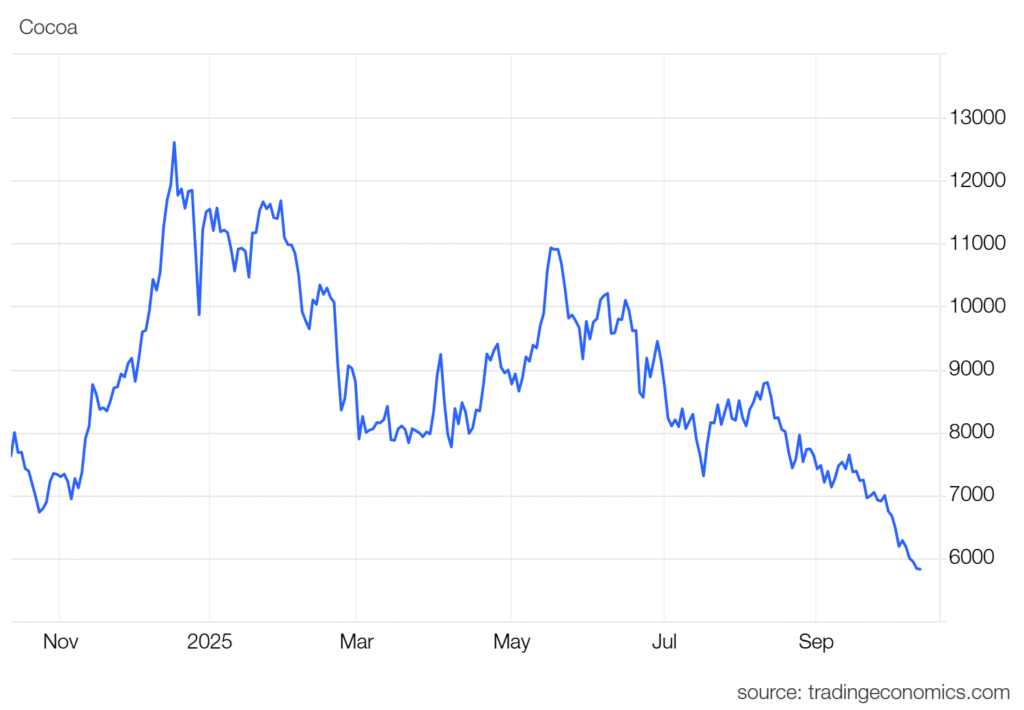Ghana’s economy is likely to experience fiscal distress as efforts to increase government revenue faces renewed threats by way of global cocoa demand decline.
Even though, Ghana’s supply side of cocoa looks promising due to this season’s reliable rainfall and increased farm gate prices amid other government policies, latest data from Bloomberg, indicated that “the demand side [for] upcoming Q3 cocoa grind data [major trading partners- U.S., Europe, and Asia] to show declines”.
For a long while now, New York has been braced with losses due to consistent fall in demand as supply surges and price falls, Bloomberg posted.
“The most-active contract [for New York] fell as much as 1% to US$ 5,888 a ton, putting prices on track for a weekly drop of about 4%. That would mark eight weeks of decline, the longest streak since May 1999.
“Prices have been falling since mid-August on expectations of a bigger surplus in the current 2025-26 season.”
Bloomberg

The market takes keen interest into the third-quarter (Q3) data to be released next week to confirm continuous demand decline as prices hit record low below US$ 6,100 per ton. According to Bloomberg, projections are expected to continue the trend affecting retailers and cocoa products.
Ghana’s revenue from cocoa exports in 2024 increased due to global cocoa price surge from US$ 1.26 in 2023 to US$ 1.7 billion, a 37.5% increase. However, exports of the cocoa beans declined over 50% in 2024 (533,057 tons in 2023 to 261,248 tons in 2024). This decline was caused by increased illegal mining, smuggling, aging plantation, and disease affecting the cocoa trees and fruit. The current production challenges warranted the new measures adopted by the two cocoa hubs to boost production.
Current producer price of cocoa
The producer price of cocoa for the 2025/2026 cocoa season for Ghana has been increased in two phases by the Producer Price Review Committee (PPRC). In August the producer price was increased to GH¢ 3,228.75 per bag and GH¢ 51,660 (US$ 5,040) per ton, representing 70% of the average Gross FoB price of US$ 7,200 per ton.
Two months later, government further increased the price to GH¢ 3,625 per bag or GH¢ 58,000 per ton representing about GH¢ 400 per bag, equivalent to a 12.27% rise over the price announced in August.
With the increase in producer price as well as establishing a scholarship scheme for the children of cocoa farmers, and provision of free inputs such as fertilizers and insecticides, output is expected to surge.
“Government remains committed to supporting the Ghana Cocoa Board to build a robust and resilient cocoa industry that provides sustainable and optimal benefits to all stakeholders.”
Dr. Cassiel Ato Forson, Minister of Finance
Ivory Coast ahead of their presidential election on October 25, witnessed producer price of cocoa increased to 2,800 CFA francs, a significant increase from the 2,200 CFA francs set in April.
Cocoa farmers in both Ghana and Ivory Coast expressed joy as their drought of price increase is finally over. President Alassane Ouattara has promised a system of purchase to ensure farmers benefit most for their cocoa.

Demand falling, price falling
Though cocoa prices increased last season, it has been volatile for a while. Cocoa price increased in early 2024 then experienced a decline since early 2025. Though cocoa prices fell, it still remains higher that 2022 figures.
Manufacturers and industries struggle with high cost and tight margins. According to Tracy Allen, an Agricultural commodities strategist, J.P. Morgan, “the second quarter [Q2] of 2025 declined by -7.2% year-over-year in Europe, -16% in Asia and -2.8% in North America.”
Demand for cocoa in the U.S., Asia, and Europe is low while price of cocoa also seems to be on the down trend can be attributed to a term called Demand Destruction.
Demand Destruction happens when consumers permanently change their behaviour because price of a good has increased or supply has decline for a period. This allows demand to fall even when supply increases.
Industrial demand for cocoa is caused by cocoa grinding. Cocoa grinding reduced in North America for Q2 of 2025 by 2.8%. Industries that process the cocoa beans grappled for a while with increased cost which they pass down to the consumers.
Therefore, even when prices fall, it takes a while for the high cost inventory to deplete to adjust to the new price fall. Hence demand continues to be low and possibly keep lowering. A product like chocolate with high price due to shortage of cocoa or high cocoa cost will experience a decrease in demand.
Current projections reveal that cocoa production or the supply of cocoa for the Q3 of the 2025/2026 cocoa season will increase because the rains are consistent alongside other favourable conditions.
Market re-calibration is required after a period of high prices which birth the Demand Destruction. As world supply recovers, the market in a period will shift back to equilibrium.




















